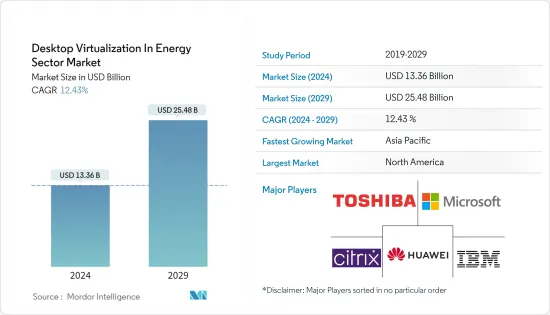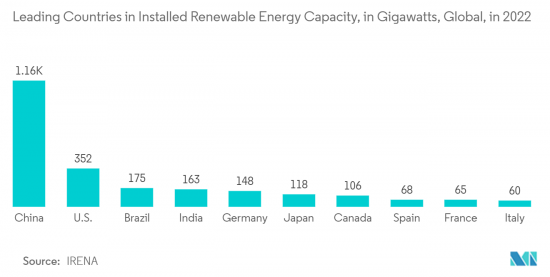 |
市場調査レポート
商品コード
1403091
エネルギー分野におけるデスクトップ仮想化-市場シェア分析、産業動向と統計、2024年~2029年の成長予測Desktop Virtualization In Energy Sector - Market Share Analysis, Industry Trends & Statistics, Growth Forecasts 2024 - 2029 |
||||||
● お客様のご希望に応じて、既存データの加工や未掲載情報(例:国別セグメント)の追加などの対応が可能です。 詳細はお問い合わせください。
| エネルギー分野におけるデスクトップ仮想化-市場シェア分析、産業動向と統計、2024年~2029年の成長予測 |
|
出版日: 2024年01月04日
発行: Mordor Intelligence
ページ情報: 英文 100 Pages
納期: 2~3営業日
|
- 全表示
- 概要
- 目次
エネルギー分野におけるデスクトップ仮想化市場規模は、2024年に133億6,000万米ドルと推定・予測され、2029年には254億8,000万米ドルに達すると予測され、予測期間中(2024~2029年)のCAGRは12.43%で成長すると予測されます。

エネルギー分野では、インフラの遠隔操作や監視が頻繁に行われます。デスクトップ仮想化により、従業員は重要なシステムやデータに遠隔地から安全にアクセスできるようになり、業務効率が向上します。
主要ハイライト
- エネルギー需要の増加に伴い、エネルギー企業は運用コストの削減とビジネスプロセスの合理化を求められています。デスクトップ環境とデータを安全なサーバーに集中させることで、デスクトップ仮想化はデータセキュリティとコンプライアンスを強化することができます。
- クラウドベースのデスクトップ仮想化により、エネルギー分野の従業員は、インターネット接続があればどこからでも仮想デスクトップと重要なアプリケーションにアクセスできます。クラウドベースのソリューションは、堅牢な災害復旧機能を提供します。災害やシステム障害が発生した場合、エネルギー企業はオフサイトのクラウドバックアップから仮想デスクトップ環境とデータを迅速に復旧できます。
- エネルギー企業はしばしば、変化する業務要件に迅速に対応する必要があります。遠隔地の掘削現場にチームを派遣する場合も、エンジニアが別の場所からデータにアクセスできるようにする場合も、デスクトップ仮想化はこうした状況の変化に適応する柔軟性を提供します。
- インフラの制約により、作業員は従来型の作業を強いられています。エネルギー分野では、複雑で確立されたプラットフォームがすでにオンプレミスにあり、クラウドへの移行には時間がかかります。クラウドベースの労働者データのセキュリティとプライバシーに関する懸念は、市場成長の妨げになると予想されます。
- AIベースの労働力分析ソリューション、労働力データソースの増加、膨大なデータへのアクセス可能性は、市場の参入企業にとって有利な機会を生み出すと予想されます。COVID-19以降、さまざまな企業がリモートワークに移行したため、市場が注目されています。ロックダウンと社会的距離のガイドラインにより、多くの企業は直ちに必要な調整を行い、リモートワーカーをサポートするために必要なコンピュータ・インフラを構築する必要に迫られました。エネルギー分野では、企業がデスクトップ仮想化ソリューションを長期にわたって使用してきました。
エネルギー分野におけるデスクトップ仮想化市場の動向
クラウド導入モードセグメントが大きな市場シェアを占める見込み
- エネルギー分野のさまざまな企業が、クラウドコンピューティングを利用して企業の運用コストを削減しています。クラウドホスティングの容易な導入、アクセス性、柔軟性が、組織のクラウドコンピューティング採用を促進すると予想されます。クラウドの導入には、DaaS(Desktop-as-a-Service)、WaaS(Workspace-as-a-Service)、SaaS(Application/Software-as-a-Service)などのサービスモデルがあります。デスクトップ仮想化は、クラウドネットワーク上のサービスとして提供され、すべてのコンピューティングとサポートインフラストラクチャは、クラウド展開形態でサービスプロバイダー側にホストされます。
- クラウド経由のアプリケーションストリーミングは、多くの企業がスタンドアロンのアプリケーションサービスを選択する中、エネルギーセクター業界で人気を集めています。クラウドは、より優れたスケーラビリティ、データ管理、コスト削減を提供するため、エネルギー分野の業界全体で好まれています。
- 国際再生可能エネルギー機関によると、2022年の世界の水力発電設備容量は1,393ギガワット(GW)に達し、2021年と比較して2.19%増加しました。水力発電の設備容量は、今後の水力発電プロジェクトや技術の進歩によって増加すると予想されます。さらに、2022年の再生可能エネルギー導入量の主要国は、中国、米国、ブラジルでした。再生可能エネルギーの導入量では、中国が約1,161ギガワットで第1位だった。
- クラウドの導入は、水力発電容量の拡大によるコンピューティング需要の増加に対応するために必要な柔軟性と拡大性を提供します。これにより、組織は必要に応じて仮想デスクトップやリソースのプロビジョニングとプロビジョニング解除を行うことができ、プロジェクトの成長に合わせることができます。
- 仮想デスクトップのクラウド展開により、重要なアプリケーションやデータへのリモートアクセスが可能になります。エンジニアは操作し、管理者はインターネット接続があればどこからでも水力プロジェクトを安全に監視・管理できるため、業務効率が向上し、現場要員の必要性が減少します。さらに2022年8月、インド政府はネパールにおける2つの水力発電プロジェクト、すなわち西セティ水力発電プロジェクトとセティ川水力発電プロジェクトの開発を発表しました。これらのプロジェクトの総事業費は約24億米ドルになる見込みです。このような新興国市場の開拓は、エネルギー分野におけるデスクトップ仮想化市場のクラウド展開形態にとってチャンスとなります。

アジア太平洋が大きな市場シェアを占める見込み
- アジア太平洋の企業が新技術をいち早く採用し、エネルギー分野に投資していることが、世界支配の主要原動力となっています。アジア太平洋におけるクラウドベースのデスクトップ仮想化導入の成長には、大手クラウドサービスプロバイダーが大きな役割を果たしています。アジア太平洋のエネルギー企業は、スマートグリッド技術など新たな製品やサービスに支えられた複雑なインフラ・ネットワークを通じて、エネルギーの送電、配電、貯蔵を行っています。
- 2022年現在、中国は再生可能エネルギー導入の世界的リーダーです。2022年の再生可能エネルギー総発電容量は1160.8GWに達し、前年比約13.4%増となります。水力、太陽光、風力が同国の主要な再生可能エネルギー源です。
- インド政府は、2022年度までに175GWの再生可能エネルギー容量を導入する目標を掲げており、その内訳は、太陽光発電が100GW、風力発電が60GW、バイオ発電が10GW、小水力発電が5GWです。さらに、インド新・再生可能エネルギー省は、2022年に再生可能エネルギー、電気自動車、ソーラー機器製造、エコ水素に150億米ドルの投資を見込んでいます。
- さらに、インド政府は二酸化炭素排出量を削減するために再生可能エネルギーに多額の投資を行い、さまざまな大規模持続可能電力プロジェクトを実施し、エコエネルギーを重点的に推進しています。2021年現在、インドの再生可能エネルギー設備容量は147GWに達しており、同国は2030年までに約450ギガワット(GW)の再生可能エネルギー設備容量を目標としています。
- 日本政府もまた、2030年までに二酸化炭素排出量を50%削減し、2050年までにカーボンニュートラルを達成することを目標としています。2022年9月、エコパワー・インベストメント(GPI)は、青森県西津軽郡深浦町にある深浦ウィンドファームの事業者としてGEリニューアブル・エナジーを選びました。このプロジェクトには、GEの陸上風力発電機4.2-117が19基導入される予定で、GEにとって日本で3番目のプロジェクトとなります。
エネルギー分野におけるデスクトップ仮想化
エネルギー分野のデスクトップ仮想化市場は細分化されており、Citrix Systems Inc.、Toshiba Corporation、IBM Corporation、Huawei Technologies、Microsoft Corporationなどの大手企業が参入しています。同市場の参入企業は、製品提供を強化し、持続可能な競争優位性を獲得するために、提携や買収などの戦略を採用しています。
2023年8月、Dell Technologiesは、仮想化アーキテクチャによる再生可能エネルギーへのシフトのサポートを発表しました。Dell Validated design for Energy Edgeは、ダイナミックで多様な再生可能エネルギー環境において、系統運用者にセキュリティと制御を提供します。このような需要に対応するため、変電所オペレータは、自動化、制御、と管理に仮想化をますます使用するようになっています。仮想化プラットフォームは、不安定で進化するグリッドにおける新たな課題に迅速に対応する柔軟性を提供します。
2022年5月、CitrixのDaaS(Desktop-as-a-Service)プラットフォームがクラウドプロバイダーと連携し、企業が仮想デスクトップ製品のホストを選択できるようになった。Citrix Systems, Inc.はGoogle Cloudと提携し、これにより、すでにオンプレミスでCitrix VDI技術を利用している企業が、Google Cloud上でホストされるCitrix DaaSに切り替えることが容易になると考えました。
その他の特典:
- エクセル形式の市場予測(ME)シート
- 3ヶ月間のアナリストサポート
目次
第1章 イントロダクション
- 調査の前提条件と市場の定義
- 調査範囲
第2章 調査手法
第3章 エグゼクティブサマリー
第4章 市場洞察
- 市場概要
- バリューチェーン分析
- 業界の魅力度-ポーターのファイブフォース分析
- 新規参入業者の脅威
- 買い手/消費者の交渉力
- 供給企業の交渉力
- 代替品の脅威
- 競争企業間の敵対関係
第5章 市場力学
- 市場促進要因
- クラウド化の進展とリモートアクセスの必要性が市場成長を促進
- 市場抑制要因
- インフラの制約が市場拡大を阻害
第6章 市場セグメンテーション
- デスクトップ配信プラットフォーム別
- ホスト型仮想デスクトップ(HVD)
- ホスト型共有デスクトップ(HSD)
- 導入形態別
- オンプレミス
- クラウド
- 地域別
- 北米
- 欧州
- アジア太平洋
- 世界のその他の中東・アフリカ
第7章 競合情勢
- 企業プロファイル
- Citrix Systems Inc.
- Toshiba Corporation
- IBM Corporation
- Huawei Technologies Co. Ltd
- Microsoft Corporation
- Parallels International GmbH
- Dell Inc.
- NComputing
- Ericom Software Inc.
- Vmware Inc.
第8章 投資分析
第9章 市場機会と今後の動向

The Desktop Virtualization In Energy Sector Market size is estimated at USD 13.36 billion in 2024, and is expected to reach USD 25.48 billion by 2029, growing at a CAGR of 12.43% during the forecast period (2024-2029).
The energy sector often involves remote operations and monitoring of infrastructure. Desktop virtualization allows employees to access critical systems and data securely from remote locations, improving operational efficiency.
Key Highlights
- The increasing energy demand necessitates energy companies to reduce operating costs and streamline business processes. By centralizing desktop environments and data on secure servers, desktop virtualization can enhance data security and compliance, which is crucial in the energy sector due to sensitive information and regulatory requirements.
- Cloud-based desktop virtualization allows energy sector employees to access their virtual desktops and critical applications from anywhere with an Internet connection. Cloud-based solutions offer robust disaster recovery capabilities. In a disaster or system failure, energy companies can quickly recover their virtual desktop environments and data from off-site cloud backups.
- Energy companies often need to respond quickly to changing operational requirements. Whether deploying a team to a remote drilling site or providing engineers with access to data from a different location, desktop virtualization offers the flexibility to adapt to these changing circumstances.
- Infrastructural constraints compel the workers to work traditionally. The energy sector already has complex and established platforms that are on-premise, and moving them to the cloud is time-consuming. Concerns about the security and privacy of cloud-based worker data are expected to hamper the market growth.
- AI-based workforce analytics solutions, an increasing number of workforce data sources, and the accessibility of vast data are expected to create lucrative opportunities for the players in the market. The market has been brought to focus since COVID-19 because various businesses have moved to remote working. The lockdown and social distancing guidelines forced many businesses to make the necessary adjustments immediately and build the computer infrastructure needed to support their remote workers. Businesses have been using desktop virtualization solutions in the energy sector for a long time.
Desktop Virtualization In Energy Sector Market Trends
Cloud Deployment Mode Segment is Expected to Hold Significant Market Share
- Various energy sector organizations are using cloud computing to reduce businesses' operational costs. Easy implementation, accessibility, and flexibility of cloud hosting are expected to drive organizations' adoption of cloud computing. Cloud deployment includes service models, such as Desktop-as-a-Service (DaaS), Workspace-as-a-Service (WaaS), and Application/Software-as-a-Service (SaaS). Desktop virtualization is offered as a service over cloud networks, with all computing and supporting infrastructure hosted on the service provider's end in the cloud deployment mode, which makes the migration of data between working environments easy.
- Application streaming over the cloud is gaining popularity in the energy sector industry, with many businesses choosing standalone application services. Cloud is preferred across energy sector industries, providing better scalability, data management, and cost savings.
- According to the International Renewable Energy Agency, in 2022, the global hydropower installed capacity reached 1393 gigawatts (GW), representing a rise of 2.19% compared to 2021. The hydropower installed capacity is expected to grow with the upcoming hydro projects and technological advancements. Furthermore, the leading countries for installed renewable energy in 2022 were China, the United States, and Brazil. China was in first place in renewable energy installations, with a capacity of around 1,161 gigawatts.
- Cloud deployment offers the flexibility and scalability required to accommodate the increasing computing demands of expanding hydropower capacity. It allows organizations to provision and de-provision virtual desktops and resources as needed, aligning with the project's growth.
- Cloud deployment of virtual desktops enables remote access to critical applications and data. Engineers operate, and managers can securely monitor and manage hydro projects from anywhere with an internet connection, improving operational efficiency and reducing the need for on-site personnel. Moreover, in August 2022, the Government of India announced the development of two hydropower projects in Nepal, namely the West Seti Hydropower Project and the Seti River Hydropower Project. The total cost of these projects is expected to be around USD 2.4 billion. Such developments provide opportunities for the cloud deployment mode of the desktop virtualization market in the energy sector.

Asia Pacific is Expected to Hold Significant Market Share
- Organizations in the Asia Pacific region companies early adoption of new technologies and investments in energy sectors are the primary driving force behind global dominance. Large cloud service providers play a significant role in the region's growth of cloud-based desktop virtualization deployment. The energy companies in the Asia Pacific region further transmit, distribute, and store energy through complex infrastructure networks supported by emerging products and services such as smart grid technologies.
- As of 2022, China is the global leader in renewable energy deployment. The country's total renewable energy capacity reached 1160.8 GW in 2022, representing an increase of approximately 13.4 percent compared to the previous year. Hydropower, solar, and wind are the major renewable energy sources in the country.
- The Government of India has set a target of installing 175 GW of renewable energy capacity by FY 2022, including 100 GW from solar, 60 GW from wind, 10 GW from bio-power, and 5 GW from small hydropower. Moreover, the Indian Ministry for New and Renewable Energy expects investment of USD 15 billion in renewable energy, electric vehicles, manufacturing of solar equipment, and green hydrogen in 2022.
- In addition, the Government of India is investing heavily in renewable energy to reduce carbon emissions, undertaking various large-scale sustainable power projects, and promoting green energy heavily. As of 2021, India's installed renewable energy capacity stood at 147 GW, and the country is targeting about 450 Gigawatt (GW) of installed renewable energy capacity by 2030, which will directly aid the market.
- Japan's government has also targeted reducing carbon emissions to 50 percent by 2030 and achieving carbon neutrality by 2050. In September 2022, Green Power Investment (GPI) chose GE Renewable Energy as the provider for the Fukaura Wind Farm in Fukaura Town, Nishi Tsugaru District, Aomori Prefecture, Japan. The project, which will include 19 units of GE's 4.2-117 onshore wind turbines, is GE's third in Japan.
Desktop Virtualization In Energy Sector Industry Overview
The desktop virtualization market in the energy sector is fragmented, with the presence of major players like Citrix Systems Inc., Toshiba Corporation, IBM Corporation, Huawei Technologies Co. Ltd, and Microsoft Corporation. Players in the market are adopting strategies such as partnerships and acquisitions to enhance their product offerings and gain sustainable competitive advantage.
In August 2023, Dell Technologies announced its support for the shift to renewable energy with virtualized architecture. Dell-validated design for Energy Edge offers grid operators security and control in dynamic, diverse renewable energy environments. To meet these demands, substation operators increasingly use virtualization for automation, control, and management. A virtualized platform provides the flexibility to quickly respond to new challenges in a volatile, evolving grid.
In May 2022 - Citrix's Desktop as a Service (Daas) platform collaborated with cloud providers, giving businesses a choice of host for their virtual desktop products. Citrix Systems, Inc. partnered with Google Cloud and believed that this would make it simpler for businesses already utilizing Citrix VDI technology on-premises to switch to Citrix DaaS hosted on Google Cloud.
Additional Benefits:
- The market estimate (ME) sheet in Excel format
- 3 months of analyst support
TABLE OF CONTENTS
1 INTRODUCTION
- 1.1 Study Assumptions and Market Defnition
- 1.2 Scope of the Study
2 RESEARCH METHODOLOGY
3 EXECUTIVE SUMMARY
4 MARKET INSIGHTS
- 4.1 Market Overview
- 4.2 Value Chain Analysis
- 4.3 Industry Attractiveness - Porter's Five Forces Analysis
- 4.3.1 Threat of New Entrants
- 4.3.2 Bargaining Power of Buyers/Consumers
- 4.3.3 Bargaining Power of Suppliers
- 4.3.4 Threat of Substitute Products
- 4.3.5 Intensity of Competitive Rivalry
5 MARKET DYNAMICS
- 5.1 Market Drivers
- 5.1.1 Growing Adoption of Cloud and Need for Remote Accessibility is Driving the Market Growth
- 5.2 Market Restraints
- 5.2.1 Infrastructural Constraints is Discouraging the Market Expansion
6 MARKET SEGMENTATION
- 6.1 By Desktop Delivery Platform
- 6.1.1 Hosted Virtual Desktop (HVD)
- 6.1.2 Hosted Shared Desktop (HSD)
- 6.2 By Deployment Mode
- 6.2.1 On-Premise
- 6.2.2 Cloud
- 6.3 By Geography
- 6.3.1 North America
- 6.3.2 Europe
- 6.3.3 Asia Pacific
- 6.3.4 Rest of the World
7 COMPETITIVE LANDSCAPE
- 7.1 Company Profiles
- 7.1.1 Citrix Systems Inc.
- 7.1.2 Toshiba Corporation
- 7.1.3 IBM Corporation
- 7.1.4 Huawei Technologies Co. Ltd
- 7.1.5 Microsoft Corporation
- 7.1.6 Parallels International GmbH
- 7.1.7 Dell Inc.
- 7.1.8 NComputing
- 7.1.9 Ericom Software Inc.
- 7.1.10 Vmware Inc.
